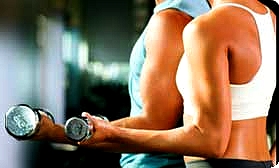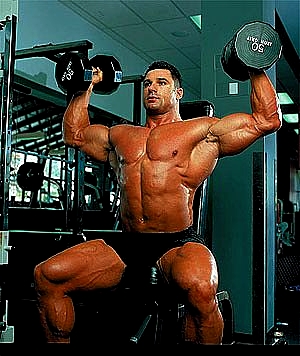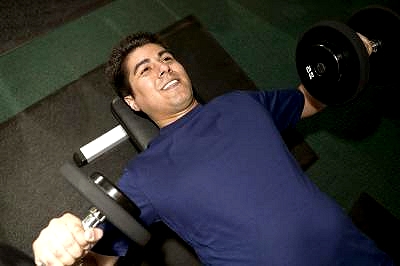High Intensity Workouts Plans, Tips, Guides - No Pain, No Gain
The phrase "no pain, no gain" has an fascinating history. Its meaning ranges for 'suffering is needed to make progress'. For exercise programs it promotes the idea that a person must work extremely hard and feel discomfort to get fit, get stronger and build muscle. Benjamin Franklin wrote, "No Gains, without Pains" in one of his books, but the phrase probably originated in the 1500s. The phrase 'Without pains, no gains' was included in John Ray's proverb collection of 1670. In modern times Jane Fonda used it in her aerobics workouts: "No pain, no gain!"
In moderation, this phrase may be a very useful for inspiring full commitment such as the 'working to failure' concept for weight training. However, the concept can be overdone and may encourage extremely short intense exercises ;that may cause injuries and be counter-productive. If its too painful, too often, people won't want to do it anymore particularly if they see no benefits. High Intensity workouts can lure people into believing their goals can be achieved very quickly, but this may be unrealistic. See weight training to build muscle. Some people may see it as a motivation for masochism loving the pain.



The concept is that making changes that last is difficult and that the transition may be painful or very hard to do. However the change won't work unless we are willing to embrace in advance, the cost and pain of the change.
Willingness to accept the pain of making changes is essential to all aspects of our lives including getting fit, building strength and changing our physical appearance.
It is not about resisting the pain of dissatisfaction in our lives but accepting the pain required to make changes.
What we call 'pain' is frequently a matter of 'extreme high-intensity' workouts 'to failure' to build strength or build muscle can be painful. The effort of thinking through a complex idea is painful. The effort of maintaining a long-term relationship can be painful. Pain is part of life.
Although the effort required to make changes is often painful our goal in life should not be to escape the effort and pain but to use the pain positively.
There’s a larger issue here about our willingness to accept the pain required to make changes. Falling short of what we are, or what we want to be, causes pain, but this pain can be negative or re-directed into a positive. What we resist, tends to persist and get worse.
Even Sigmund Freud said, “A person should not strive to eliminate his complexes but to get into accord with them.” Pain has no value in itself but is inevitable - its part of life. There are smart ways of dealing with pain beyond resisting it. Making changes in our lives to requires effort and we need to be willing to cope with the pain of making the changes.
Quote:
The 'No Pain, No Gain' concept encompasses the notion of trying to make changes in out lives will cause pain and we must accept the pain to gain the benefits we are seeking.

Do Extreme Workouts and Actions Work?
Are the high-octane, short and high intensity workouts the way to go for getting fit or building strength or muscle? Likewise for other activities, are there benefits with the high intensity approach?
The 'No pain, No gain' strategy can get you fast results, but there is evidence that these hard-earned results won't last unless you know how to do it properly.
Ideally a person should go hard during one session and easy on the next. This allows your body to recover.
- Your routine should include some recovery exercises.
- You need to give your body time to heal.
- High intensity strength training and muscle building involves doing heavy weight repetitions to the point of failure. This type of training is directed at building muscle using heavy loads and continuous bursts of extreme muscle tension. You stimulate your body to increase the size of the muscles and make your muscles stronger, more efficient and larger. It is not aerobic and does not build endurance.
Pros of High Intensity Training and Activities
High intensity strength training is known to be very effective for burning fat. During recovery the body's resting metabolic rate increases and this boosts the number of calories consumed for the exercise. This type of training may be 2-4 times more effective for weight loss programs than other methods. Many forms of aerobic and endurance exercises using smaller loads and more repetitions may cause loss of muscle mass while you are working out, but with high intensity strength training, you will always gain muscle.
Cons of High Intensity Training and Activities
The boundaries between lifting weights to failure and over-training are not always clear, especially when there are no signs of strain or injury. Learning to read the warning signs is important. High intensity training is designed to be stressful and painful - you are putting your muscles under extreme strain in order to induce increases in muscle mass, but over-training is always a danger and you must allow time for recovery between sessions.
Just because a high intensity workout takes less time to complete does not mean it will be less of a strain on the body. In fact, these workouts will generally be harder and more tiring than your typical cardiovascular workout.
This type of workout does not help to increase your endurance or aerobic fitness, but it is focuses purely on building muscle.
Tips for a Safe High Intensity Workouts and Activities
- Train no more than 3 times per week, with at least 24-48 hours of rest between sessions.
- Keep the sessions short but intense with brief breaks between sets
- Use weights and compound exercises, but be sure to work each group of muscles to exhaustion
- Don’t use more than twelve exercises for any given training session.
- Move from one exercise to the next with a short rest.
- Work well beyond the aerobic level
- Work the entire body in each session using compound weight lifts, instead of focusing on legs or arms, upper or lower body only. This increases the stimulus on the body to build extra muscle.